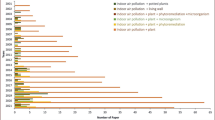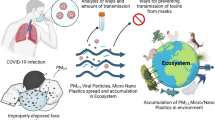Abstract
Purpose
The aim of this study was to analyze air concentrations of chemical and microbiological pollutants in the vicinity of an organic waste treatment plant, Ecoparc-2, located in Montcada i Reixac (Catalonia, Spain), as well as to determine the seasonal trends. The human health risks due to the presence of those agents were also assessed.
Methods
Air samples were collected at different distances and wind directions from the Ecoparc-2 in two campaigns (winter and summer of 2010). The levels of 19 volatile organic compounds (VOCs) were analyzed by GC-MS or HPLC-UV. In turn, the airborne amount of total bacteria, gram-negative bacteria, and fungi (including Aspergillus fumigatus) was also determined.
Results
Mean VOC concentrations were found to be 32.4 and 15.7 μg/m3 in winter and summer, respectively. Fungi at 25°C presented the highest geometric mean (1,126 and 863 cfu/m3 in winter and summer, respectively), while the concentrations of fungi at 37°C and total bacteria were also important in the hot season (332 and 250 cfu/m3, respectively). These results are in agreement with data obtained from the scientific literature. Anyhow, no significant differences were observed between both campaigns including those related to distances and wind directions. The current pollutant levels in the surrounding environment were also various orders of magnitude lower than those recently observed inside the facility.
Conclusions
The human exposure to VOCs near the Ecoparc-2 was estimated to be low. Furthermore, the current environmental concentrations of those chemical and microbiological agents were clearly below threshold values recommended by regulatory organizations.



Similar content being viewed by others
References
Aydogdu H, Asan A, Tatman Otkun M (2010) Indoor and outdoor airborne bacteria in child day-care centers in Edirne City (Turkey), seasonal distribution and influence of meteorological factors. Environ Monit Assess 164:53–66
Bono R, Degan R, Pazzi M, Romanazzi V, Rovere R (2010) Benzene and formaldehyde in air of two winter Olympic venues of "Torino 2006". Environ Int 36:269–275
Chen YP, Cui Y, Dong JG (2010) Variation of airborne bacteria and fungi at Emperor Qin's Terra-Cotta Museum, Xi'an, China, during the “Oct. 1” Gold Week Period of 2006. Environ Sci Pollut Res 17:478–485
de Araújo ASF, de Melo WJ, Singh RP (2010) Municipal solid waste compost amendment in agricultural soil: changes in soil microbial biomass. Rev Environ Sci Biotechnol 9:41–49
Déportes I, Benoit-Guyod J-L, Zmirou D (1995) Hazard to man and the environment posed by the use of urban waste compost: a review. Sci Total Environ 172:197–222
Domingo JL, Nadal M (2009) Domestic waste composting facilities: a review of human health risks. Environ Int 35:382–389
Donovan SM, Bateson T, Gronow JR, Voulvoulis N (2010) Modelling the behaviour of mechanical biological treatment outputs in landfills using the GasSim model. Sci Total Environ 408:1979–1984
Durmusoglu E, Taspinar F, Karademir A (2010) Health risk assessment of BTEX emissions in the landfill environment. J Hazard Mater 176:870–877
Eitzer BD (1995) Emissions of volatile organic chemicals from municipal solid waste composting facilities. Environ Sci Technol 29:896–902
Esplugues A, Ballester F, Estarlich M, Llop S, Fuentes-Leonarte V, Mantilla E, Iñiguez C (2010) Indoor and outdoor air concentrations of BTEX and determinants in a cohort of one-year old children in Valencia, Spain. Sci Total Environ 409:63–69
Gallego E, Roca FX, Guardino X, Rosell MG (2008) Indoor and outdoor BTX levels in Barcelona City metropolitan area and Catalan rural areas. J Environ Sci 20:1063–1069
Giakoumi A, Maggos TH, Michopoulos J, Helmis C, Vasilakos CH (2009) PM2.5 and volatile organic compounds (VOCs) in ambient air: a focus on the effect of meteorology. Environ Monit Assess 152:83–95
Giusti L (2009) A review of waste management practices and their impact on human health. Waste Manage 29:2227–2239
Grisoli P, Rodolfi M, Villani S, Grignani E, Cottica D, Berri A, Maria Picco A, Dacarro C (2009) Assessment of airborne microorganism contamination in an industrial area characterized by an open composting facility and a wastewater treatment plant. Environ Res 109:135–142
Guinea J, Peláez T, Alcalá L, Bouza E (2006) Outdoor environmental levels of Aspergillus spp. conidia over a wide geographical area. Med Mycol 44:349–356
Hargreaves JC, Adl MS, Warman PR (2008) A review of the use of composted municipal solid waste in agriculture. Agric Ecosyst Environ 123:1–14
Jung KH, Artigas F, Shin JY (2011) Personal, indoor, and outdoor exposure to VOCs in the immediate vicinity of a local airport. Environ Monit Assess 173:555–567
Kotzias D, Koistinen K, Kephalopoulos S, Schlitt C, Carrer P, Maroni M, Jantunen M, Cochet C, Kirchner S, Lindvall T, McLaughlin J, Mølhave L, de Oliveira Fernandes E, Seifert B (2005) The INDEX project. Critical appraisal of the setting and implementation of indoor exposure limits in the EU. European Commission, Institute for Health and Consumer Protection, Physical and Chemical Exposure Unit, Ispra, pp 1–50, 275–281
Król S, Zabiegala B, Namieśnik J (2010) Monitoring VOCs in atmospheric air I. On-line gas analyzers. Trac Tren Anal Chem 29:1092–1100
Linares V, Perelló G, Nadal M, Gómez-Catalán J, Llobet JM, Domingo JL (2010) Environmental versus dietary exposure to POPs and metals: a probabilistic assessment of human health risks. J Environ Monit 12:681–688
López E, Schuhmacher M, Domingo JL (2008) Human health risks of petroleum-contaminated groundwater. Environ Sci Pollut Res 15:278–288
Massolo L, Rehwagen M, Porta A, Ronco A, Herbarth O, Mueller A (2010) Indoor-outdoor distribution and risk assessment of volatile organic compounds in the atmosphere of industrial and urban areas. Environ Toxicol 25:339–349
MMA (2007) Guía Técnica de aplicación del RD 9/2005, de 14 de enero, por el que se establece la relación de actividades potencialmente contaminantes del suelo y los criterios y estándares para la declaración de suelos contaminados. Dirección General de Calidad y Evaluación Ambiental, Ministerio de Medio Ambiente (in Spanish)
Müller T, Thissen R, Braun S, Dott W, Fischer G (2004a) (M)VOC and composting facilities part 2: (M)VOC dispersal in the environment. Environ Sci Pollut Res 11:152–157
Müller T, Thissen R, Braun S, Dott W, Fischer G (2004b) (M)VOC and composting facilities: Part 1: (M)VOC emissions from municipal biowaste and plant refuse. Environ Sci Pollut Res 11:91–97
Nadal M, Inza I, Schuhmacher M, Figueras MJ, Domingo JL (2009) Health risks of the occupational exposure to microbiological and chemical pollutants in a municipal waste organic fraction treatment plant. Int J Hyg Environ Health 212:661–669
Pankhurst LJ, Akeel U, Hewson C, Maduka I, Pham P, Saragossi J, Taylor J, Lai KM (2011) Understanding and mitigating the challenge of bioaerosol emissions from urban community composting. Atmos Environ 45:85–93
Parra MA, Elustondo D, Bermejo R, Santamaría JM (2009) Ambient air levels of volatile organic compounds (VOC) and nitrogen dioxide (NO2) in a medium size city in Northern Spain. Sci Total Environ 407:999–1009
Pekey B, Yilmaz H (2011) The use of passive sampling to monitor spatial trends of volatile organic compounds (VOCs) at an industrial city of Turkey. Microchem J 97:213–219
Persoons R, Parat S, Stoklov M, Perdrix A, Maitre A (2010) Critical working tasks and determinants of exposure to bioaerosols and MVOC at composting facilities. Int J Hyg Environ Health 213:338–347
Ras MR, Marcé RM, Borrull F (2010) Volatile organic compounds in air at urban and industrial areas in the Tarragona region by thermal desorption and gas chromatography-mass spectrometry. Environ Monit Assess 161:389–402
Ras-Mallorquí MR, Marcè-Recasens RM, Borrull-Ballarín F (2007) Determination of volatile organic compounds in urban and industrial air from Tarragona by thermal desorption and gas chromatography-mass spectrometry. Talanta 72:941–950
Sánchez-Monedero MA, Stentiford EI, Urpilainen ST (2005) Bioaerosol generation at large-scale green waste composting plants. J Air Waste Manage Assoc 55:612–618
Sykes P, Jones K, Wildsmith JD (2007) Managing the potential public health risks from bioaerosol liberation at commercial composting sites in the UK: an analysis of the evidence base. Resour Conserv Recy 52:410–424
Tang X, Bai Y, Duong A, Smith MT, Li L, Zhang L (2009) Formaldehyde in China: production, consumption, exposure levels, and health effects. Environ Int 35:1210–1224
US EPA (2009) Risk assessment guidance for superfund volume I: human health evaluation manual (part F, supplemental guidance for inhalation risk assessment). United States Environmental Protection Agency. Office of Superfund Remediation and Technology Innovation, EPA-540-R-070-002
Vilavert L, Nadal M, Inza I, Figueras MJ, Domingo JL (2009) Baseline levels of bioaerosols and volatile organic compounds around a municipal waste incinerator prior to the construction of a mechanical-biological treatment plant. Waste Manage 29:2454–2461
Yoon C, Lee K, Park D (2011) Indoor air quality differences between urban and rural preschools in Korea. Environ Sci Pollut Res 18:333–345
Acknowledgments
The present study was financially supported by the Spanish Ministry of Science and Innovation, through the project CTM2009-09338. Gloria Sanchez and Jessica Jimenez are acknowledged for providing valuation information for air sampling.
Author information
Authors and Affiliations
Corresponding author
Additional information
Responsible editor: Euripides Stephanou
Rights and permissions
About this article
Cite this article
Vilavert, L., Nadal, M., Figueras, M.J. et al. Volatile organic compounds and bioaerosols in the vicinity of a municipal waste organic fraction treatment plant. Human health risks. Environ Sci Pollut Res 19, 96–104 (2012). https://doi.org/10.1007/s11356-011-0547-8
Received:
Accepted:
Published:
Issue Date:
DOI: https://doi.org/10.1007/s11356-011-0547-8




